Leadership and Management Roles and Functions in Iceland Supermarket
VerifiedAdded on 2020/02/17
|15
|5180
|42
Report
AI Summary
This report offers a comprehensive analysis of leadership and management practices within the context of Iceland, a UK-based supermarket chain. It begins by differentiating between the roles and characteristics of leaders and managers, highlighting their distinct approaches to decision-making, problem-solving, and team management. The report then delves into the practical application of various leadership theories, including the contingency model, situational leadership, and systems leadership, evaluating their strengths and weaknesses. Furthermore, it explores the operational management strategies employed by Iceland, examining the factors influencing decision-making and the methods used to enhance efficiency. The report also considers the external factors impacting the business environment and provides a critical evaluation of operational management approaches. The content is designed to provide insights into effective leadership and management within a real-world business setting, with a focus on practical applications and theoretical frameworks. The report concludes by summarizing the key findings and offering insights into optimizing leadership and management practices within the organization.
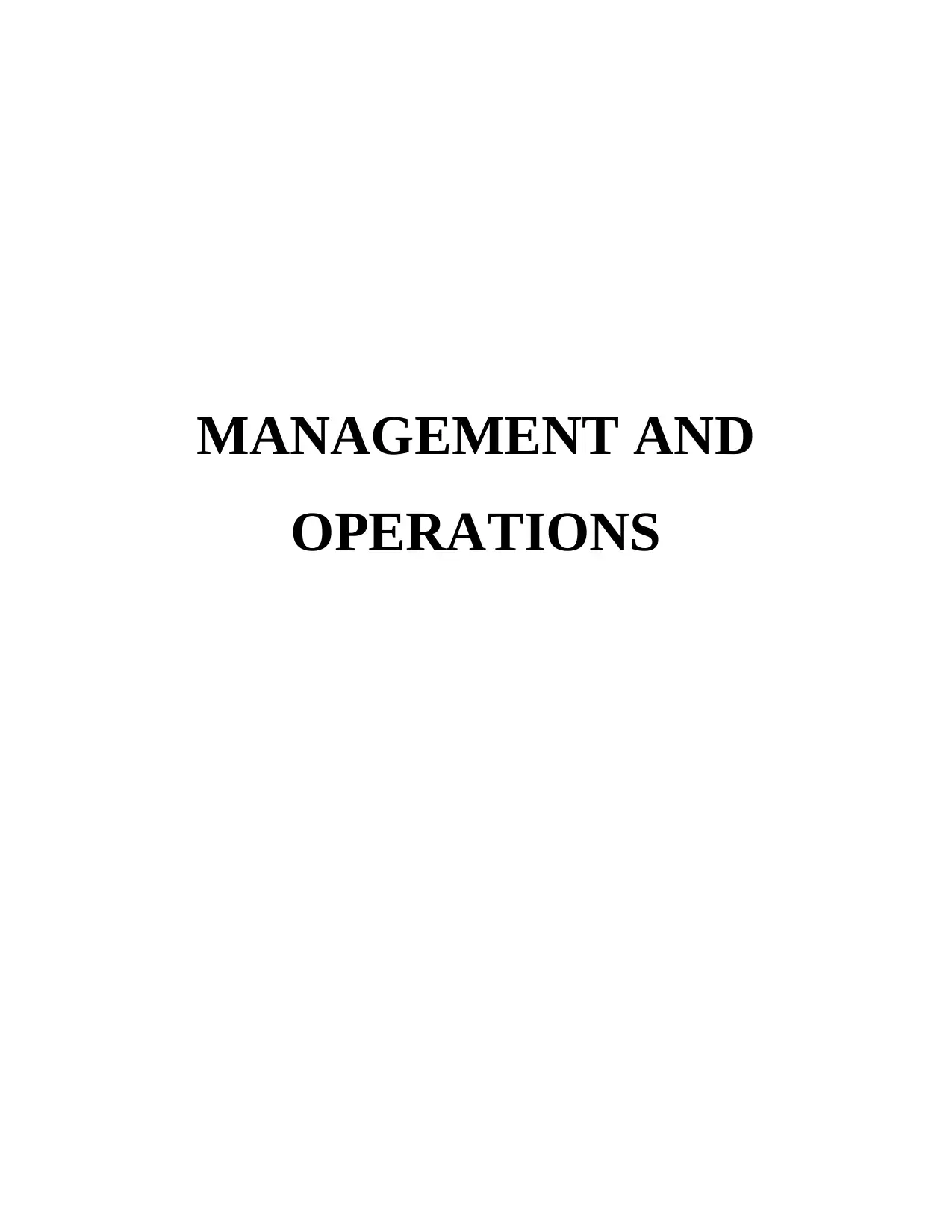
MANAGEMENT AND
OPERATIONS
OPERATIONS
Paraphrase This Document
Need a fresh take? Get an instant paraphrase of this document with our AI Paraphraser
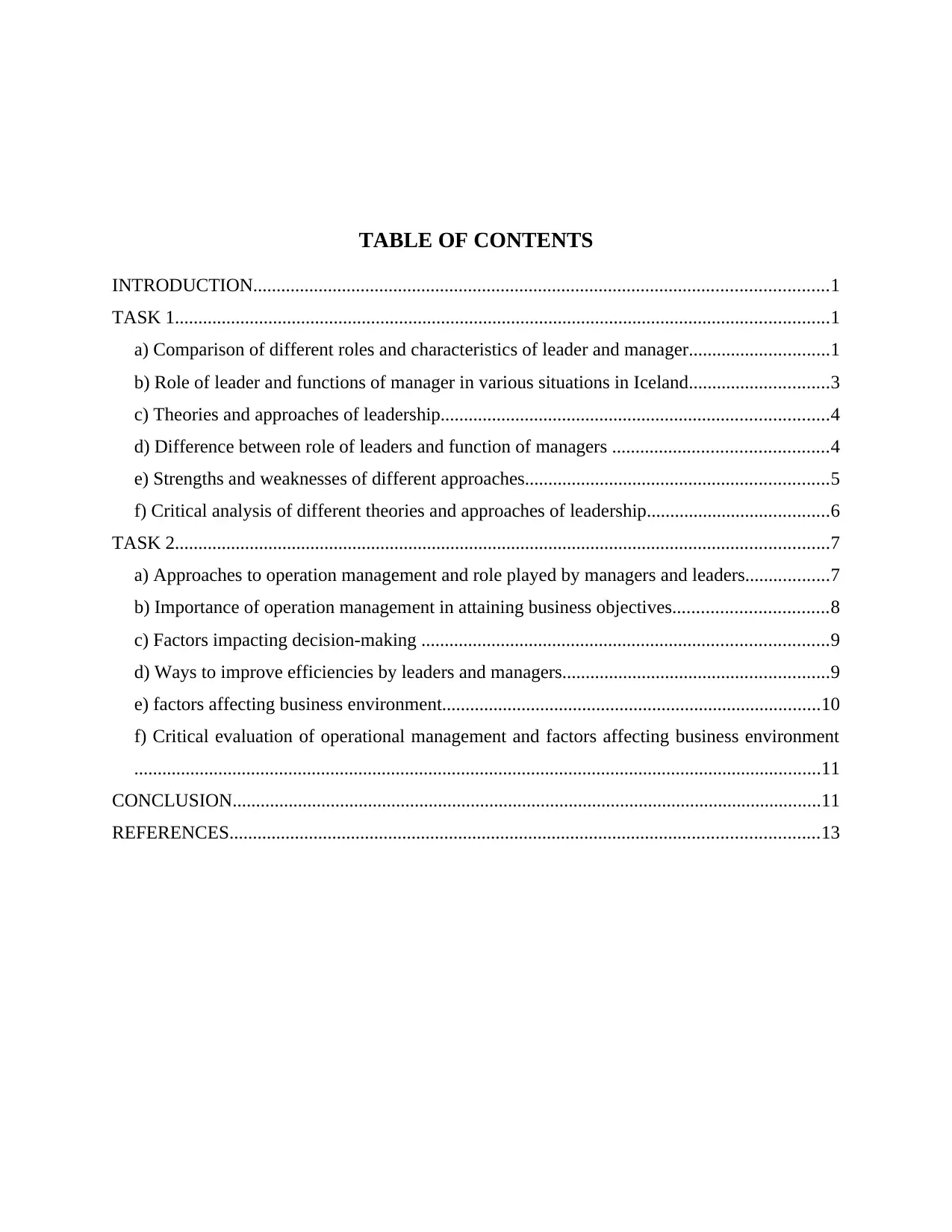
TABLE OF CONTENTS
INTRODUCTION...........................................................................................................................1
TASK 1............................................................................................................................................1
a) Comparison of different roles and characteristics of leader and manager..............................1
b) Role of leader and functions of manager in various situations in Iceland..............................3
c) Theories and approaches of leadership...................................................................................4
d) Difference between role of leaders and function of managers ..............................................4
e) Strengths and weaknesses of different approaches.................................................................5
f) Critical analysis of different theories and approaches of leadership.......................................6
TASK 2............................................................................................................................................7
a) Approaches to operation management and role played by managers and leaders..................7
b) Importance of operation management in attaining business objectives.................................8
c) Factors impacting decision-making .......................................................................................9
d) Ways to improve efficiencies by leaders and managers.........................................................9
e) factors affecting business environment.................................................................................10
f) Critical evaluation of operational management and factors affecting business environment
...................................................................................................................................................11
CONCLUSION..............................................................................................................................11
REFERENCES..............................................................................................................................13
INTRODUCTION...........................................................................................................................1
TASK 1............................................................................................................................................1
a) Comparison of different roles and characteristics of leader and manager..............................1
b) Role of leader and functions of manager in various situations in Iceland..............................3
c) Theories and approaches of leadership...................................................................................4
d) Difference between role of leaders and function of managers ..............................................4
e) Strengths and weaknesses of different approaches.................................................................5
f) Critical analysis of different theories and approaches of leadership.......................................6
TASK 2............................................................................................................................................7
a) Approaches to operation management and role played by managers and leaders..................7
b) Importance of operation management in attaining business objectives.................................8
c) Factors impacting decision-making .......................................................................................9
d) Ways to improve efficiencies by leaders and managers.........................................................9
e) factors affecting business environment.................................................................................10
f) Critical evaluation of operational management and factors affecting business environment
...................................................................................................................................................11
CONCLUSION..............................................................................................................................11
REFERENCES..............................................................................................................................13
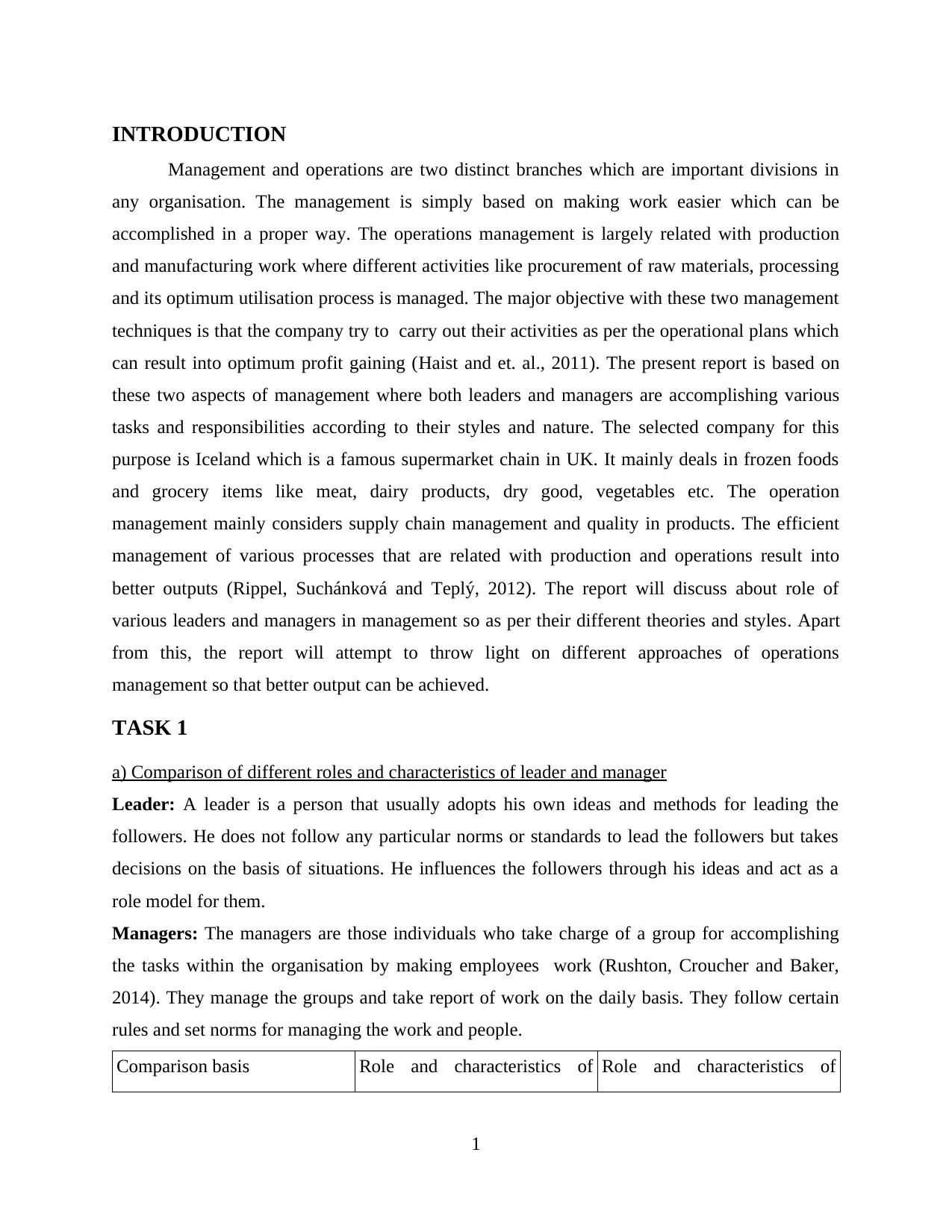
INTRODUCTION
Management and operations are two distinct branches which are important divisions in
any organisation. The management is simply based on making work easier which can be
accomplished in a proper way. The operations management is largely related with production
and manufacturing work where different activities like procurement of raw materials, processing
and its optimum utilisation process is managed. The major objective with these two management
techniques is that the company try to carry out their activities as per the operational plans which
can result into optimum profit gaining (Haist and et. al., 2011). The present report is based on
these two aspects of management where both leaders and managers are accomplishing various
tasks and responsibilities according to their styles and nature. The selected company for this
purpose is Iceland which is a famous supermarket chain in UK. It mainly deals in frozen foods
and grocery items like meat, dairy products, dry good, vegetables etc. The operation
management mainly considers supply chain management and quality in products. The efficient
management of various processes that are related with production and operations result into
better outputs (Rippel, Suchánková and Teplý, 2012). The report will discuss about role of
various leaders and managers in management so as per their different theories and styles. Apart
from this, the report will attempt to throw light on different approaches of operations
management so that better output can be achieved.
TASK 1
a) Comparison of different roles and characteristics of leader and manager
Leader: A leader is a person that usually adopts his own ideas and methods for leading the
followers. He does not follow any particular norms or standards to lead the followers but takes
decisions on the basis of situations. He influences the followers through his ideas and act as a
role model for them.
Managers: The managers are those individuals who take charge of a group for accomplishing
the tasks within the organisation by making employees work (Rushton, Croucher and Baker,
2014). They manage the groups and take report of work on the daily basis. They follow certain
rules and set norms for managing the work and people.
Comparison basis Role and characteristics of Role and characteristics of
1
Management and operations are two distinct branches which are important divisions in
any organisation. The management is simply based on making work easier which can be
accomplished in a proper way. The operations management is largely related with production
and manufacturing work where different activities like procurement of raw materials, processing
and its optimum utilisation process is managed. The major objective with these two management
techniques is that the company try to carry out their activities as per the operational plans which
can result into optimum profit gaining (Haist and et. al., 2011). The present report is based on
these two aspects of management where both leaders and managers are accomplishing various
tasks and responsibilities according to their styles and nature. The selected company for this
purpose is Iceland which is a famous supermarket chain in UK. It mainly deals in frozen foods
and grocery items like meat, dairy products, dry good, vegetables etc. The operation
management mainly considers supply chain management and quality in products. The efficient
management of various processes that are related with production and operations result into
better outputs (Rippel, Suchánková and Teplý, 2012). The report will discuss about role of
various leaders and managers in management so as per their different theories and styles. Apart
from this, the report will attempt to throw light on different approaches of operations
management so that better output can be achieved.
TASK 1
a) Comparison of different roles and characteristics of leader and manager
Leader: A leader is a person that usually adopts his own ideas and methods for leading the
followers. He does not follow any particular norms or standards to lead the followers but takes
decisions on the basis of situations. He influences the followers through his ideas and act as a
role model for them.
Managers: The managers are those individuals who take charge of a group for accomplishing
the tasks within the organisation by making employees work (Rushton, Croucher and Baker,
2014). They manage the groups and take report of work on the daily basis. They follow certain
rules and set norms for managing the work and people.
Comparison basis Role and characteristics of Role and characteristics of
1
⊘ This is a preview!⊘
Do you want full access?
Subscribe today to unlock all pages.

Trusted by 1+ million students worldwide
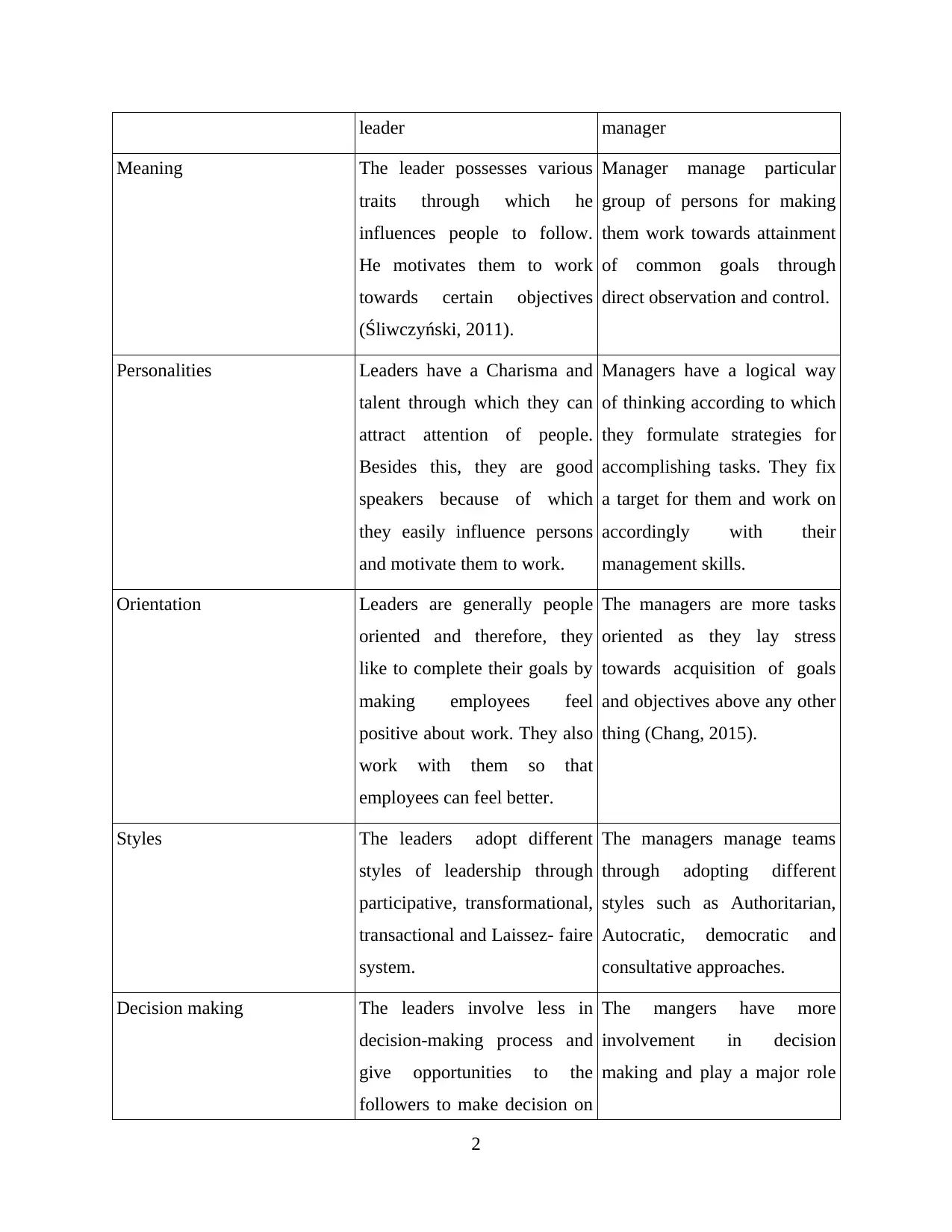
leader manager
Meaning The leader possesses various
traits through which he
influences people to follow.
He motivates them to work
towards certain objectives
(Śliwczyński, 2011).
Manager manage particular
group of persons for making
them work towards attainment
of common goals through
direct observation and control.
Personalities Leaders have a Charisma and
talent through which they can
attract attention of people.
Besides this, they are good
speakers because of which
they easily influence persons
and motivate them to work.
Managers have a logical way
of thinking according to which
they formulate strategies for
accomplishing tasks. They fix
a target for them and work on
accordingly with their
management skills.
Orientation Leaders are generally people
oriented and therefore, they
like to complete their goals by
making employees feel
positive about work. They also
work with them so that
employees can feel better.
The managers are more tasks
oriented as they lay stress
towards acquisition of goals
and objectives above any other
thing (Chang, 2015).
Styles The leaders adopt different
styles of leadership through
participative, transformational,
transactional and Laissez- faire
system.
The managers manage teams
through adopting different
styles such as Authoritarian,
Autocratic, democratic and
consultative approaches.
Decision making The leaders involve less in
decision-making process and
give opportunities to the
followers to make decision on
The mangers have more
involvement in decision
making and play a major role
2
Meaning The leader possesses various
traits through which he
influences people to follow.
He motivates them to work
towards certain objectives
(Śliwczyński, 2011).
Manager manage particular
group of persons for making
them work towards attainment
of common goals through
direct observation and control.
Personalities Leaders have a Charisma and
talent through which they can
attract attention of people.
Besides this, they are good
speakers because of which
they easily influence persons
and motivate them to work.
Managers have a logical way
of thinking according to which
they formulate strategies for
accomplishing tasks. They fix
a target for them and work on
accordingly with their
management skills.
Orientation Leaders are generally people
oriented and therefore, they
like to complete their goals by
making employees feel
positive about work. They also
work with them so that
employees can feel better.
The managers are more tasks
oriented as they lay stress
towards acquisition of goals
and objectives above any other
thing (Chang, 2015).
Styles The leaders adopt different
styles of leadership through
participative, transformational,
transactional and Laissez- faire
system.
The managers manage teams
through adopting different
styles such as Authoritarian,
Autocratic, democratic and
consultative approaches.
Decision making The leaders involve less in
decision-making process and
give opportunities to the
followers to make decision on
The mangers have more
involvement in decision
making and play a major role
2
Paraphrase This Document
Need a fresh take? Get an instant paraphrase of this document with our AI Paraphraser
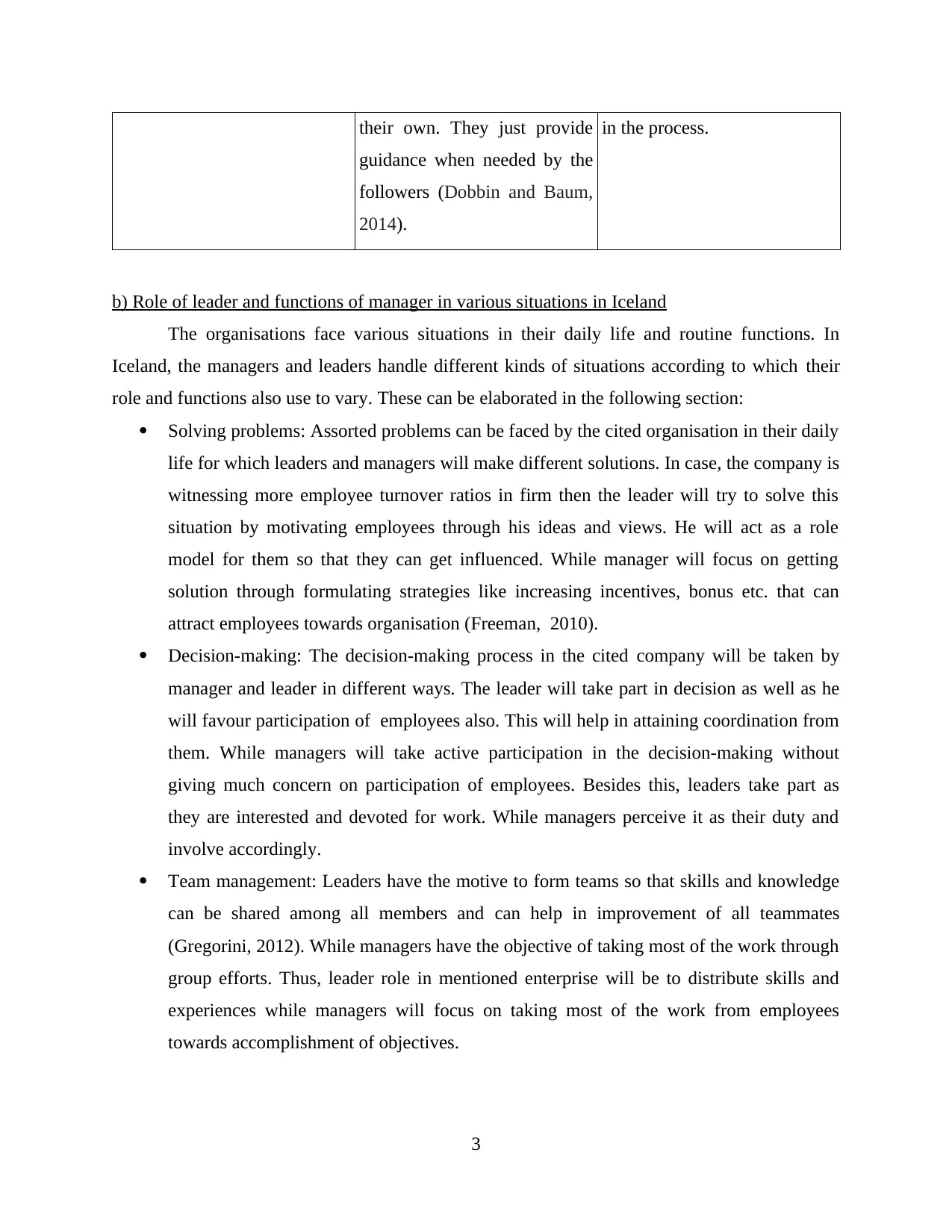
their own. They just provide
guidance when needed by the
followers (Dobbin and Baum,
2014).
in the process.
b) Role of leader and functions of manager in various situations in Iceland
The organisations face various situations in their daily life and routine functions. In
Iceland, the managers and leaders handle different kinds of situations according to which their
role and functions also use to vary. These can be elaborated in the following section:
Solving problems: Assorted problems can be faced by the cited organisation in their daily
life for which leaders and managers will make different solutions. In case, the company is
witnessing more employee turnover ratios in firm then the leader will try to solve this
situation by motivating employees through his ideas and views. He will act as a role
model for them so that they can get influenced. While manager will focus on getting
solution through formulating strategies like increasing incentives, bonus etc. that can
attract employees towards organisation (Freeman, 2010).
Decision-making: The decision-making process in the cited company will be taken by
manager and leader in different ways. The leader will take part in decision as well as he
will favour participation of employees also. This will help in attaining coordination from
them. While managers will take active participation in the decision-making without
giving much concern on participation of employees. Besides this, leaders take part as
they are interested and devoted for work. While managers perceive it as their duty and
involve accordingly.
Team management: Leaders have the motive to form teams so that skills and knowledge
can be shared among all members and can help in improvement of all teammates
(Gregorini, 2012). While managers have the objective of taking most of the work through
group efforts. Thus, leader role in mentioned enterprise will be to distribute skills and
experiences while managers will focus on taking most of the work from employees
towards accomplishment of objectives.
3
guidance when needed by the
followers (Dobbin and Baum,
2014).
in the process.
b) Role of leader and functions of manager in various situations in Iceland
The organisations face various situations in their daily life and routine functions. In
Iceland, the managers and leaders handle different kinds of situations according to which their
role and functions also use to vary. These can be elaborated in the following section:
Solving problems: Assorted problems can be faced by the cited organisation in their daily
life for which leaders and managers will make different solutions. In case, the company is
witnessing more employee turnover ratios in firm then the leader will try to solve this
situation by motivating employees through his ideas and views. He will act as a role
model for them so that they can get influenced. While manager will focus on getting
solution through formulating strategies like increasing incentives, bonus etc. that can
attract employees towards organisation (Freeman, 2010).
Decision-making: The decision-making process in the cited company will be taken by
manager and leader in different ways. The leader will take part in decision as well as he
will favour participation of employees also. This will help in attaining coordination from
them. While managers will take active participation in the decision-making without
giving much concern on participation of employees. Besides this, leaders take part as
they are interested and devoted for work. While managers perceive it as their duty and
involve accordingly.
Team management: Leaders have the motive to form teams so that skills and knowledge
can be shared among all members and can help in improvement of all teammates
(Gregorini, 2012). While managers have the objective of taking most of the work through
group efforts. Thus, leader role in mentioned enterprise will be to distribute skills and
experiences while managers will focus on taking most of the work from employees
towards accomplishment of objectives.
3
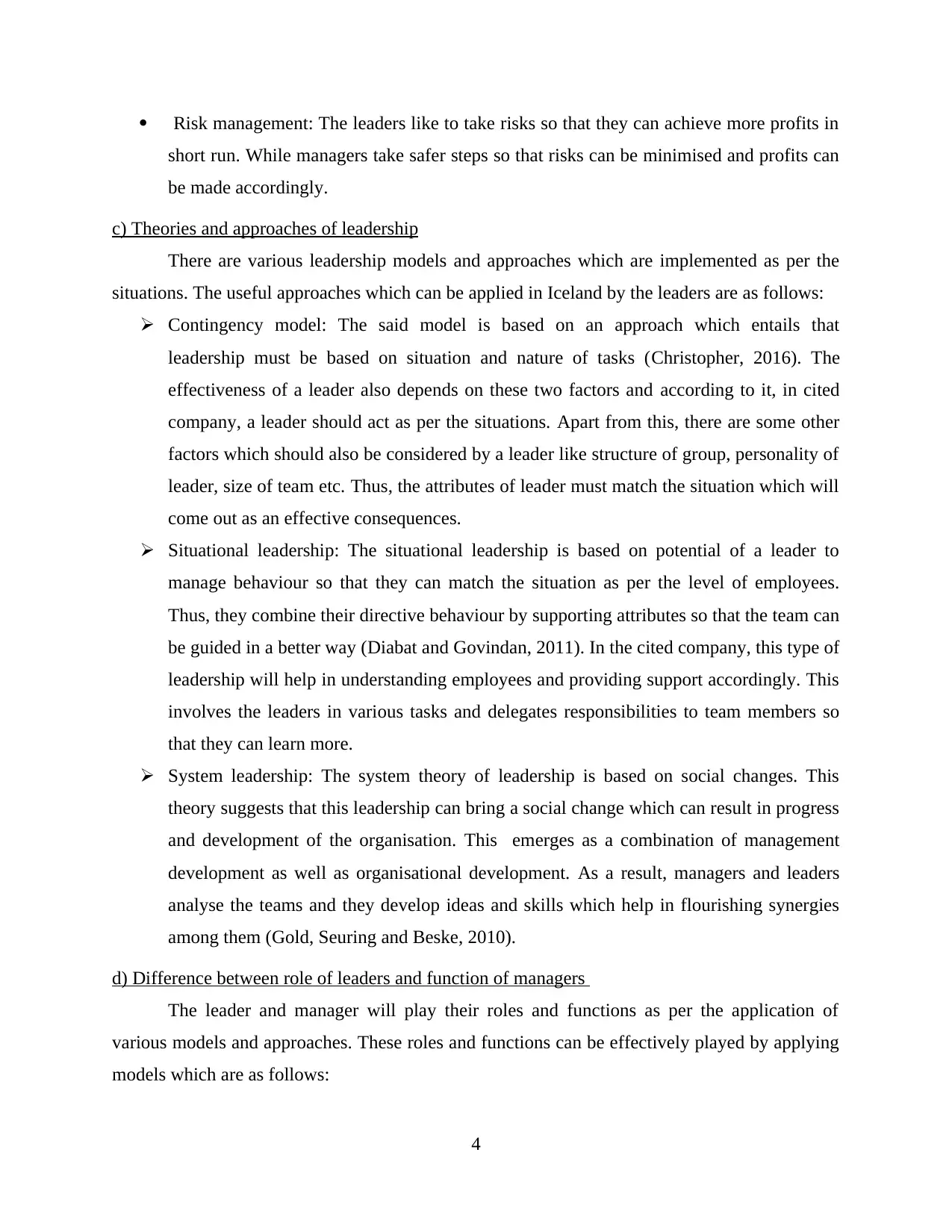
Risk management: The leaders like to take risks so that they can achieve more profits in
short run. While managers take safer steps so that risks can be minimised and profits can
be made accordingly.
c) Theories and approaches of leadership
There are various leadership models and approaches which are implemented as per the
situations. The useful approaches which can be applied in Iceland by the leaders are as follows:
Contingency model: The said model is based on an approach which entails that
leadership must be based on situation and nature of tasks (Christopher, 2016). The
effectiveness of a leader also depends on these two factors and according to it, in cited
company, a leader should act as per the situations. Apart from this, there are some other
factors which should also be considered by a leader like structure of group, personality of
leader, size of team etc. Thus, the attributes of leader must match the situation which will
come out as an effective consequences.
Situational leadership: The situational leadership is based on potential of a leader to
manage behaviour so that they can match the situation as per the level of employees.
Thus, they combine their directive behaviour by supporting attributes so that the team can
be guided in a better way (Diabat and Govindan, 2011). In the cited company, this type of
leadership will help in understanding employees and providing support accordingly. This
involves the leaders in various tasks and delegates responsibilities to team members so
that they can learn more.
System leadership: The system theory of leadership is based on social changes. This
theory suggests that this leadership can bring a social change which can result in progress
and development of the organisation. This emerges as a combination of management
development as well as organisational development. As a result, managers and leaders
analyse the teams and they develop ideas and skills which help in flourishing synergies
among them (Gold, Seuring and Beske, 2010).
d) Difference between role of leaders and function of managers
The leader and manager will play their roles and functions as per the application of
various models and approaches. These roles and functions can be effectively played by applying
models which are as follows:
4
short run. While managers take safer steps so that risks can be minimised and profits can
be made accordingly.
c) Theories and approaches of leadership
There are various leadership models and approaches which are implemented as per the
situations. The useful approaches which can be applied in Iceland by the leaders are as follows:
Contingency model: The said model is based on an approach which entails that
leadership must be based on situation and nature of tasks (Christopher, 2016). The
effectiveness of a leader also depends on these two factors and according to it, in cited
company, a leader should act as per the situations. Apart from this, there are some other
factors which should also be considered by a leader like structure of group, personality of
leader, size of team etc. Thus, the attributes of leader must match the situation which will
come out as an effective consequences.
Situational leadership: The situational leadership is based on potential of a leader to
manage behaviour so that they can match the situation as per the level of employees.
Thus, they combine their directive behaviour by supporting attributes so that the team can
be guided in a better way (Diabat and Govindan, 2011). In the cited company, this type of
leadership will help in understanding employees and providing support accordingly. This
involves the leaders in various tasks and delegates responsibilities to team members so
that they can learn more.
System leadership: The system theory of leadership is based on social changes. This
theory suggests that this leadership can bring a social change which can result in progress
and development of the organisation. This emerges as a combination of management
development as well as organisational development. As a result, managers and leaders
analyse the teams and they develop ideas and skills which help in flourishing synergies
among them (Gold, Seuring and Beske, 2010).
d) Difference between role of leaders and function of managers
The leader and manager will play their roles and functions as per the application of
various models and approaches. These roles and functions can be effectively played by applying
models which are as follows:
4
⊘ This is a preview!⊘
Do you want full access?
Subscribe today to unlock all pages.

Trusted by 1+ million students worldwide
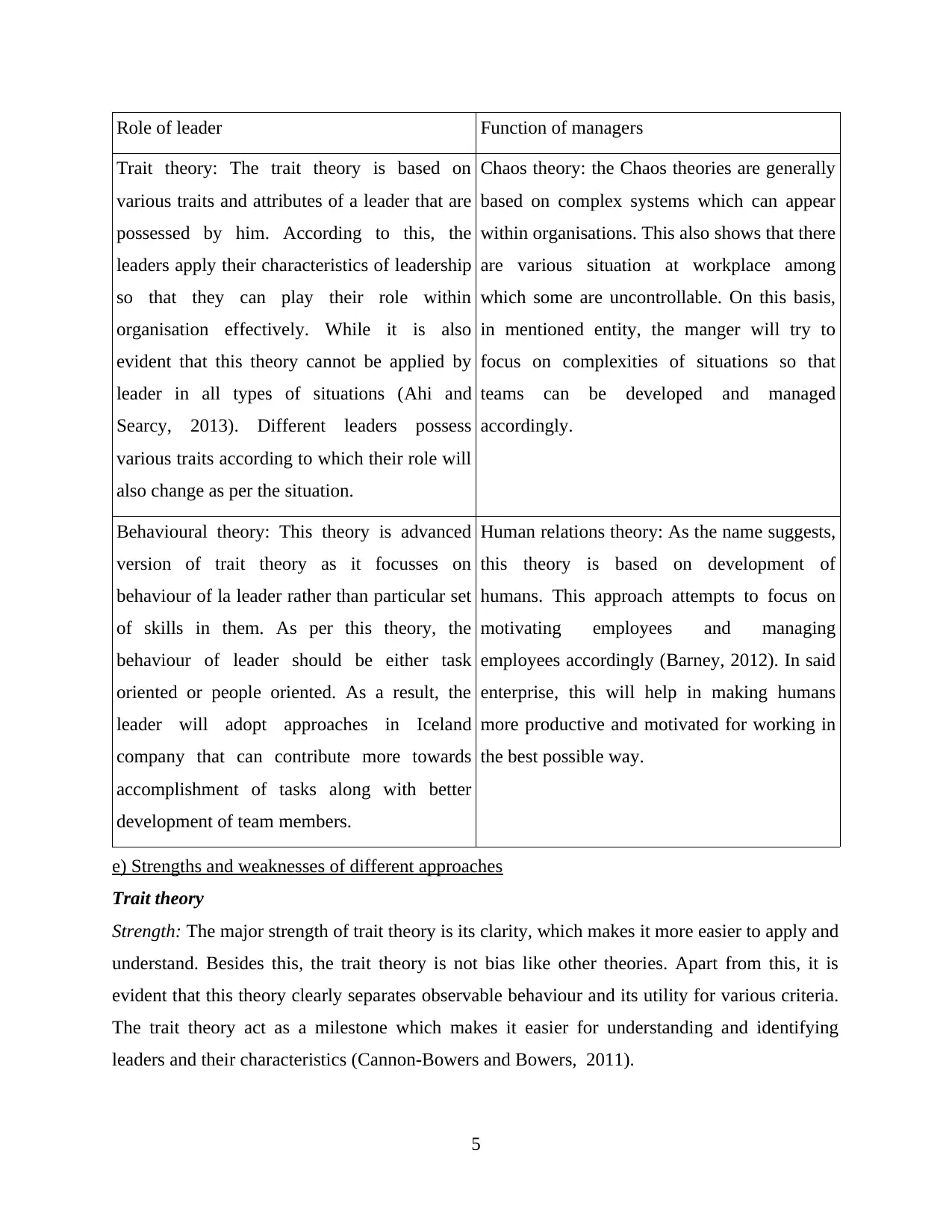
Role of leader Function of managers
Trait theory: The trait theory is based on
various traits and attributes of a leader that are
possessed by him. According to this, the
leaders apply their characteristics of leadership
so that they can play their role within
organisation effectively. While it is also
evident that this theory cannot be applied by
leader in all types of situations (Ahi and
Searcy, 2013). Different leaders possess
various traits according to which their role will
also change as per the situation.
Chaos theory: the Chaos theories are generally
based on complex systems which can appear
within organisations. This also shows that there
are various situation at workplace among
which some are uncontrollable. On this basis,
in mentioned entity, the manger will try to
focus on complexities of situations so that
teams can be developed and managed
accordingly.
Behavioural theory: This theory is advanced
version of trait theory as it focusses on
behaviour of la leader rather than particular set
of skills in them. As per this theory, the
behaviour of leader should be either task
oriented or people oriented. As a result, the
leader will adopt approaches in Iceland
company that can contribute more towards
accomplishment of tasks along with better
development of team members.
Human relations theory: As the name suggests,
this theory is based on development of
humans. This approach attempts to focus on
motivating employees and managing
employees accordingly (Barney, 2012). In said
enterprise, this will help in making humans
more productive and motivated for working in
the best possible way.
e) Strengths and weaknesses of different approaches
Trait theory
Strength: The major strength of trait theory is its clarity, which makes it more easier to apply and
understand. Besides this, the trait theory is not bias like other theories. Apart from this, it is
evident that this theory clearly separates observable behaviour and its utility for various criteria.
The trait theory act as a milestone which makes it easier for understanding and identifying
leaders and their characteristics (Cannon-Bowers and Bowers, 2011).
5
Trait theory: The trait theory is based on
various traits and attributes of a leader that are
possessed by him. According to this, the
leaders apply their characteristics of leadership
so that they can play their role within
organisation effectively. While it is also
evident that this theory cannot be applied by
leader in all types of situations (Ahi and
Searcy, 2013). Different leaders possess
various traits according to which their role will
also change as per the situation.
Chaos theory: the Chaos theories are generally
based on complex systems which can appear
within organisations. This also shows that there
are various situation at workplace among
which some are uncontrollable. On this basis,
in mentioned entity, the manger will try to
focus on complexities of situations so that
teams can be developed and managed
accordingly.
Behavioural theory: This theory is advanced
version of trait theory as it focusses on
behaviour of la leader rather than particular set
of skills in them. As per this theory, the
behaviour of leader should be either task
oriented or people oriented. As a result, the
leader will adopt approaches in Iceland
company that can contribute more towards
accomplishment of tasks along with better
development of team members.
Human relations theory: As the name suggests,
this theory is based on development of
humans. This approach attempts to focus on
motivating employees and managing
employees accordingly (Barney, 2012). In said
enterprise, this will help in making humans
more productive and motivated for working in
the best possible way.
e) Strengths and weaknesses of different approaches
Trait theory
Strength: The major strength of trait theory is its clarity, which makes it more easier to apply and
understand. Besides this, the trait theory is not bias like other theories. Apart from this, it is
evident that this theory clearly separates observable behaviour and its utility for various criteria.
The trait theory act as a milestone which makes it easier for understanding and identifying
leaders and their characteristics (Cannon-Bowers and Bowers, 2011).
5
Paraphrase This Document
Need a fresh take? Get an instant paraphrase of this document with our AI Paraphraser
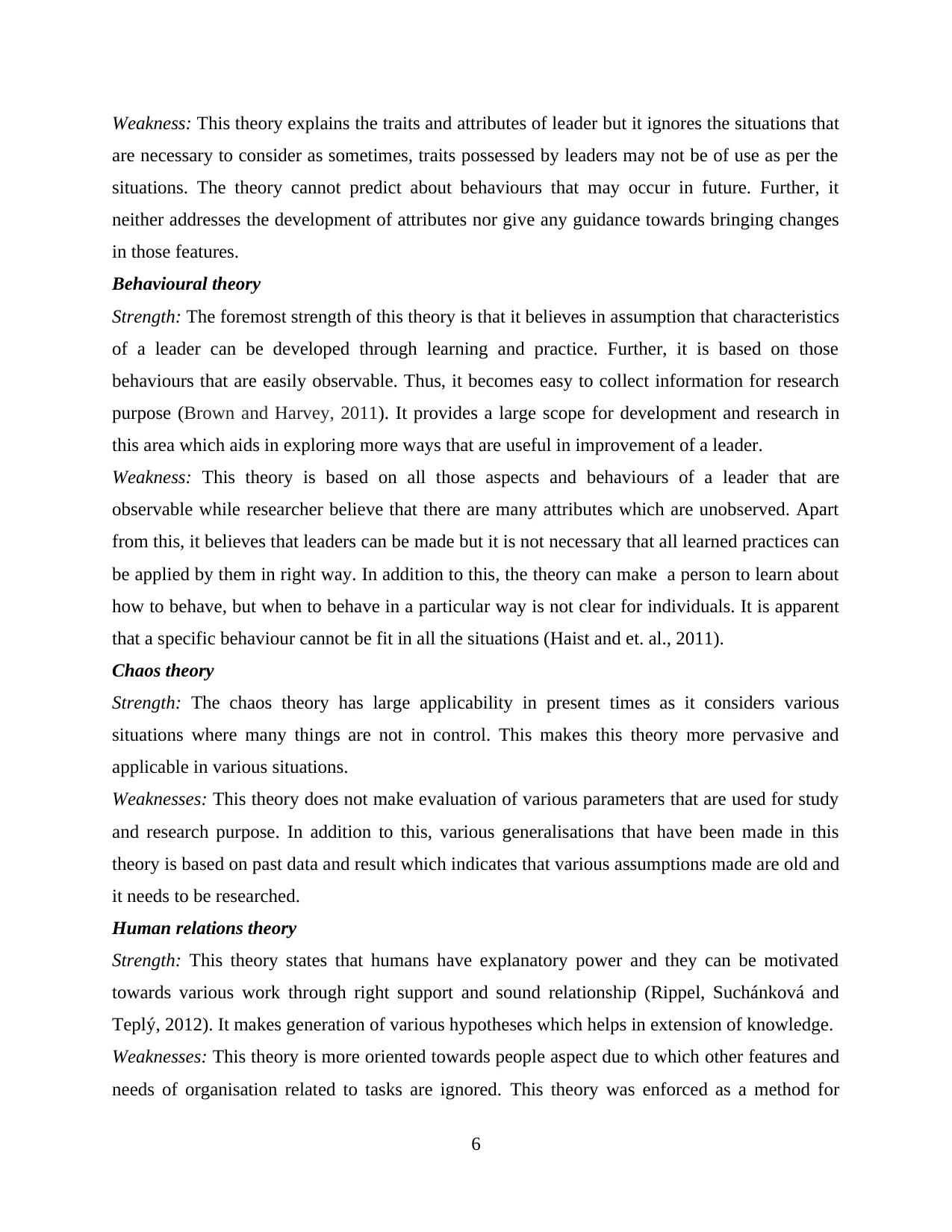
Weakness: This theory explains the traits and attributes of leader but it ignores the situations that
are necessary to consider as sometimes, traits possessed by leaders may not be of use as per the
situations. The theory cannot predict about behaviours that may occur in future. Further, it
neither addresses the development of attributes nor give any guidance towards bringing changes
in those features.
Behavioural theory
Strength: The foremost strength of this theory is that it believes in assumption that characteristics
of a leader can be developed through learning and practice. Further, it is based on those
behaviours that are easily observable. Thus, it becomes easy to collect information for research
purpose (Brown and Harvey, 2011). It provides a large scope for development and research in
this area which aids in exploring more ways that are useful in improvement of a leader.
Weakness: This theory is based on all those aspects and behaviours of a leader that are
observable while researcher believe that there are many attributes which are unobserved. Apart
from this, it believes that leaders can be made but it is not necessary that all learned practices can
be applied by them in right way. In addition to this, the theory can make a person to learn about
how to behave, but when to behave in a particular way is not clear for individuals. It is apparent
that a specific behaviour cannot be fit in all the situations (Haist and et. al., 2011).
Chaos theory
Strength: The chaos theory has large applicability in present times as it considers various
situations where many things are not in control. This makes this theory more pervasive and
applicable in various situations.
Weaknesses: This theory does not make evaluation of various parameters that are used for study
and research purpose. In addition to this, various generalisations that have been made in this
theory is based on past data and result which indicates that various assumptions made are old and
it needs to be researched.
Human relations theory
Strength: This theory states that humans have explanatory power and they can be motivated
towards various work through right support and sound relationship (Rippel, Suchánková and
Teplý, 2012). It makes generation of various hypotheses which helps in extension of knowledge.
Weaknesses: This theory is more oriented towards people aspect due to which other features and
needs of organisation related to tasks are ignored. This theory was enforced as a method for
6
are necessary to consider as sometimes, traits possessed by leaders may not be of use as per the
situations. The theory cannot predict about behaviours that may occur in future. Further, it
neither addresses the development of attributes nor give any guidance towards bringing changes
in those features.
Behavioural theory
Strength: The foremost strength of this theory is that it believes in assumption that characteristics
of a leader can be developed through learning and practice. Further, it is based on those
behaviours that are easily observable. Thus, it becomes easy to collect information for research
purpose (Brown and Harvey, 2011). It provides a large scope for development and research in
this area which aids in exploring more ways that are useful in improvement of a leader.
Weakness: This theory is based on all those aspects and behaviours of a leader that are
observable while researcher believe that there are many attributes which are unobserved. Apart
from this, it believes that leaders can be made but it is not necessary that all learned practices can
be applied by them in right way. In addition to this, the theory can make a person to learn about
how to behave, but when to behave in a particular way is not clear for individuals. It is apparent
that a specific behaviour cannot be fit in all the situations (Haist and et. al., 2011).
Chaos theory
Strength: The chaos theory has large applicability in present times as it considers various
situations where many things are not in control. This makes this theory more pervasive and
applicable in various situations.
Weaknesses: This theory does not make evaluation of various parameters that are used for study
and research purpose. In addition to this, various generalisations that have been made in this
theory is based on past data and result which indicates that various assumptions made are old and
it needs to be researched.
Human relations theory
Strength: This theory states that humans have explanatory power and they can be motivated
towards various work through right support and sound relationship (Rippel, Suchánková and
Teplý, 2012). It makes generation of various hypotheses which helps in extension of knowledge.
Weaknesses: This theory is more oriented towards people aspect due to which other features and
needs of organisation related to tasks are ignored. This theory was enforced as a method for
6
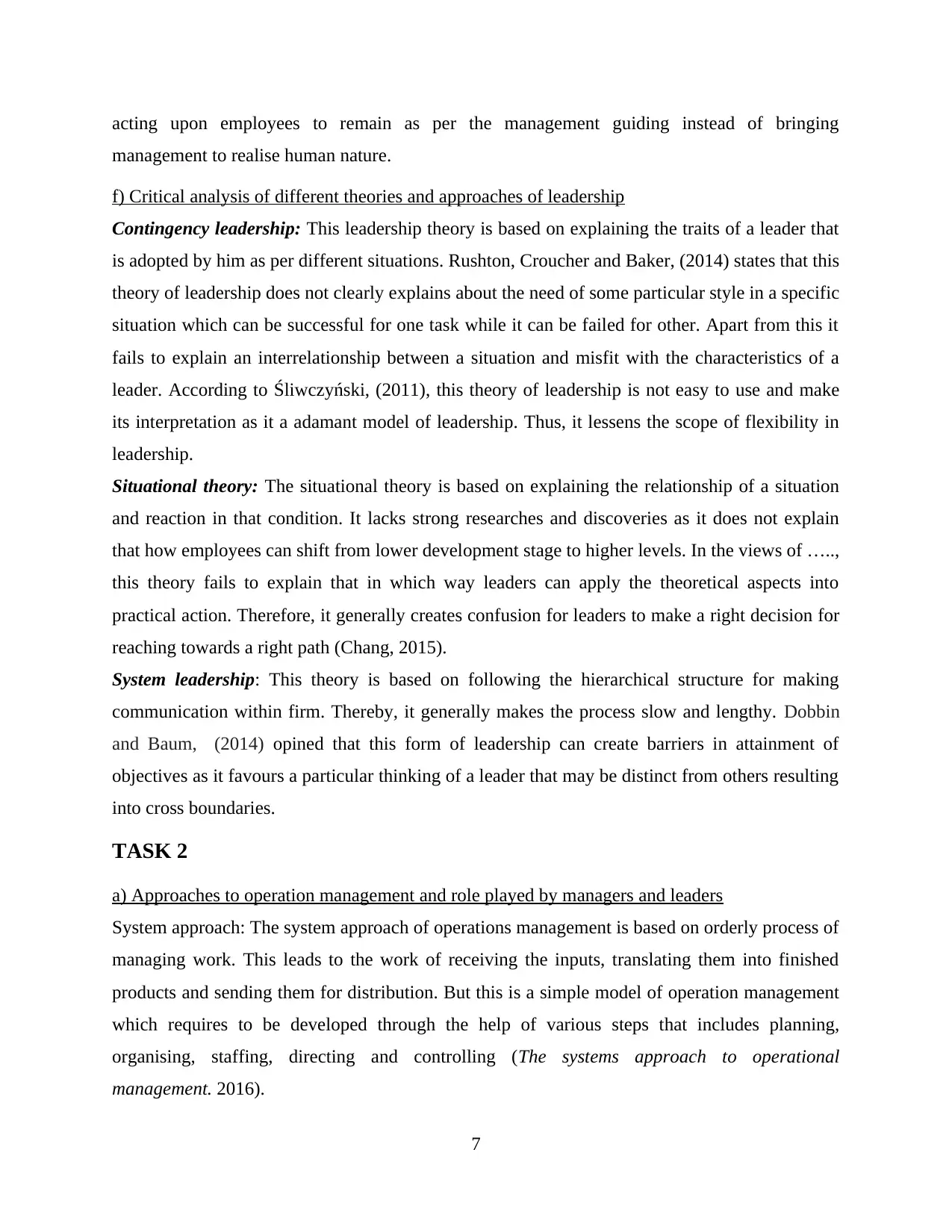
acting upon employees to remain as per the management guiding instead of bringing
management to realise human nature.
f) Critical analysis of different theories and approaches of leadership
Contingency leadership: This leadership theory is based on explaining the traits of a leader that
is adopted by him as per different situations. Rushton, Croucher and Baker, (2014) states that this
theory of leadership does not clearly explains about the need of some particular style in a specific
situation which can be successful for one task while it can be failed for other. Apart from this it
fails to explain an interrelationship between a situation and misfit with the characteristics of a
leader. According to Śliwczyński, (2011), this theory of leadership is not easy to use and make
its interpretation as it a adamant model of leadership. Thus, it lessens the scope of flexibility in
leadership.
Situational theory: The situational theory is based on explaining the relationship of a situation
and reaction in that condition. It lacks strong researches and discoveries as it does not explain
that how employees can shift from lower development stage to higher levels. In the views of …..,
this theory fails to explain that in which way leaders can apply the theoretical aspects into
practical action. Therefore, it generally creates confusion for leaders to make a right decision for
reaching towards a right path (Chang, 2015).
System leadership: This theory is based on following the hierarchical structure for making
communication within firm. Thereby, it generally makes the process slow and lengthy. Dobbin
and Baum, (2014) opined that this form of leadership can create barriers in attainment of
objectives as it favours a particular thinking of a leader that may be distinct from others resulting
into cross boundaries.
TASK 2
a) Approaches to operation management and role played by managers and leaders
System approach: The system approach of operations management is based on orderly process of
managing work. This leads to the work of receiving the inputs, translating them into finished
products and sending them for distribution. But this is a simple model of operation management
which requires to be developed through the help of various steps that includes planning,
organising, staffing, directing and controlling (The systems approach to operational
management. 2016).
7
management to realise human nature.
f) Critical analysis of different theories and approaches of leadership
Contingency leadership: This leadership theory is based on explaining the traits of a leader that
is adopted by him as per different situations. Rushton, Croucher and Baker, (2014) states that this
theory of leadership does not clearly explains about the need of some particular style in a specific
situation which can be successful for one task while it can be failed for other. Apart from this it
fails to explain an interrelationship between a situation and misfit with the characteristics of a
leader. According to Śliwczyński, (2011), this theory of leadership is not easy to use and make
its interpretation as it a adamant model of leadership. Thus, it lessens the scope of flexibility in
leadership.
Situational theory: The situational theory is based on explaining the relationship of a situation
and reaction in that condition. It lacks strong researches and discoveries as it does not explain
that how employees can shift from lower development stage to higher levels. In the views of …..,
this theory fails to explain that in which way leaders can apply the theoretical aspects into
practical action. Therefore, it generally creates confusion for leaders to make a right decision for
reaching towards a right path (Chang, 2015).
System leadership: This theory is based on following the hierarchical structure for making
communication within firm. Thereby, it generally makes the process slow and lengthy. Dobbin
and Baum, (2014) opined that this form of leadership can create barriers in attainment of
objectives as it favours a particular thinking of a leader that may be distinct from others resulting
into cross boundaries.
TASK 2
a) Approaches to operation management and role played by managers and leaders
System approach: The system approach of operations management is based on orderly process of
managing work. This leads to the work of receiving the inputs, translating them into finished
products and sending them for distribution. But this is a simple model of operation management
which requires to be developed through the help of various steps that includes planning,
organising, staffing, directing and controlling (The systems approach to operational
management. 2016).
7
⊘ This is a preview!⊘
Do you want full access?
Subscribe today to unlock all pages.

Trusted by 1+ million students worldwide
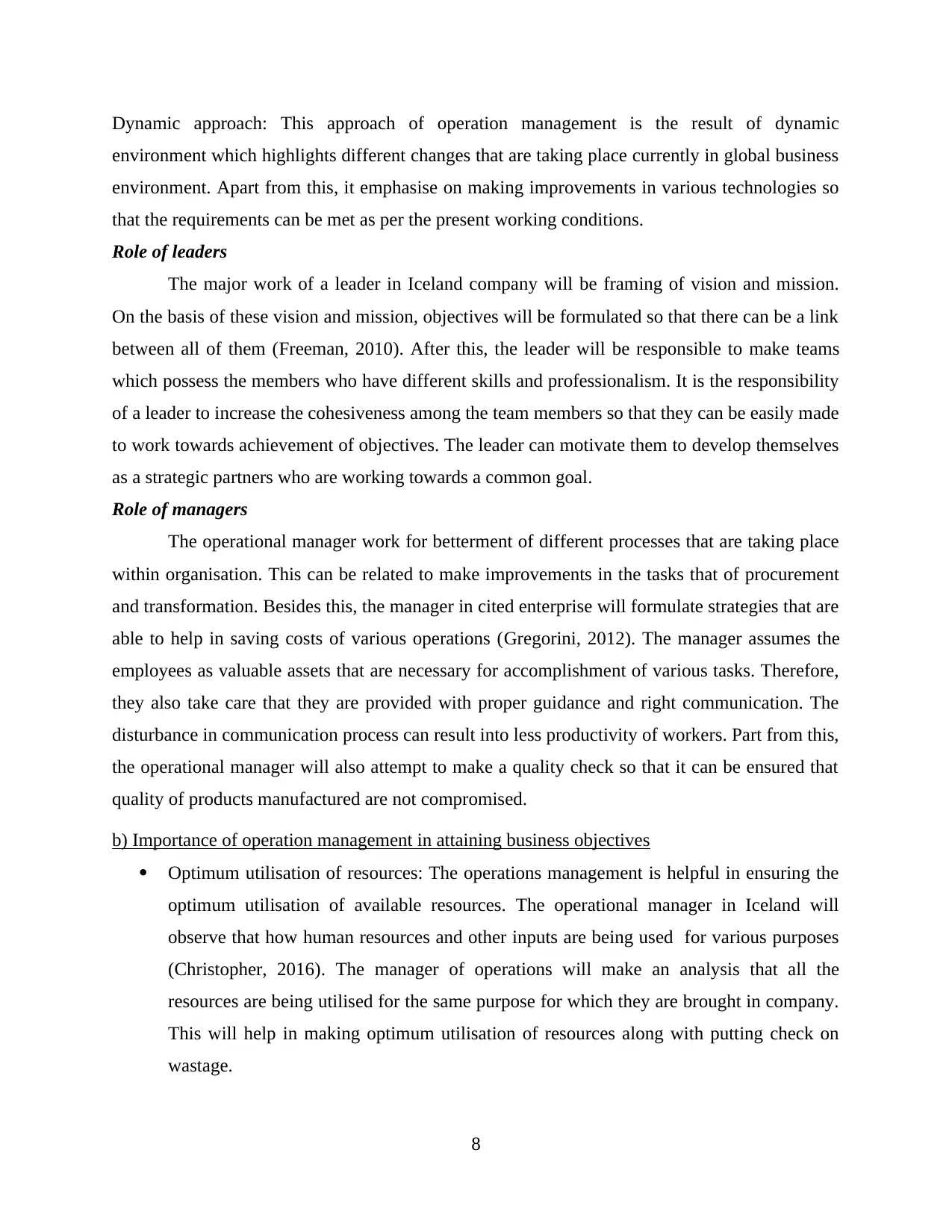
Dynamic approach: This approach of operation management is the result of dynamic
environment which highlights different changes that are taking place currently in global business
environment. Apart from this, it emphasise on making improvements in various technologies so
that the requirements can be met as per the present working conditions.
Role of leaders
The major work of a leader in Iceland company will be framing of vision and mission.
On the basis of these vision and mission, objectives will be formulated so that there can be a link
between all of them (Freeman, 2010). After this, the leader will be responsible to make teams
which possess the members who have different skills and professionalism. It is the responsibility
of a leader to increase the cohesiveness among the team members so that they can be easily made
to work towards achievement of objectives. The leader can motivate them to develop themselves
as a strategic partners who are working towards a common goal.
Role of managers
The operational manager work for betterment of different processes that are taking place
within organisation. This can be related to make improvements in the tasks that of procurement
and transformation. Besides this, the manager in cited enterprise will formulate strategies that are
able to help in saving costs of various operations (Gregorini, 2012). The manager assumes the
employees as valuable assets that are necessary for accomplishment of various tasks. Therefore,
they also take care that they are provided with proper guidance and right communication. The
disturbance in communication process can result into less productivity of workers. Part from this,
the operational manager will also attempt to make a quality check so that it can be ensured that
quality of products manufactured are not compromised.
b) Importance of operation management in attaining business objectives
Optimum utilisation of resources: The operations management is helpful in ensuring the
optimum utilisation of available resources. The operational manager in Iceland will
observe that how human resources and other inputs are being used for various purposes
(Christopher, 2016). The manager of operations will make an analysis that all the
resources are being utilised for the same purpose for which they are brought in company.
This will help in making optimum utilisation of resources along with putting check on
wastage.
8
environment which highlights different changes that are taking place currently in global business
environment. Apart from this, it emphasise on making improvements in various technologies so
that the requirements can be met as per the present working conditions.
Role of leaders
The major work of a leader in Iceland company will be framing of vision and mission.
On the basis of these vision and mission, objectives will be formulated so that there can be a link
between all of them (Freeman, 2010). After this, the leader will be responsible to make teams
which possess the members who have different skills and professionalism. It is the responsibility
of a leader to increase the cohesiveness among the team members so that they can be easily made
to work towards achievement of objectives. The leader can motivate them to develop themselves
as a strategic partners who are working towards a common goal.
Role of managers
The operational manager work for betterment of different processes that are taking place
within organisation. This can be related to make improvements in the tasks that of procurement
and transformation. Besides this, the manager in cited enterprise will formulate strategies that are
able to help in saving costs of various operations (Gregorini, 2012). The manager assumes the
employees as valuable assets that are necessary for accomplishment of various tasks. Therefore,
they also take care that they are provided with proper guidance and right communication. The
disturbance in communication process can result into less productivity of workers. Part from this,
the operational manager will also attempt to make a quality check so that it can be ensured that
quality of products manufactured are not compromised.
b) Importance of operation management in attaining business objectives
Optimum utilisation of resources: The operations management is helpful in ensuring the
optimum utilisation of available resources. The operational manager in Iceland will
observe that how human resources and other inputs are being used for various purposes
(Christopher, 2016). The manager of operations will make an analysis that all the
resources are being utilised for the same purpose for which they are brought in company.
This will help in making optimum utilisation of resources along with putting check on
wastage.
8
Paraphrase This Document
Need a fresh take? Get an instant paraphrase of this document with our AI Paraphraser
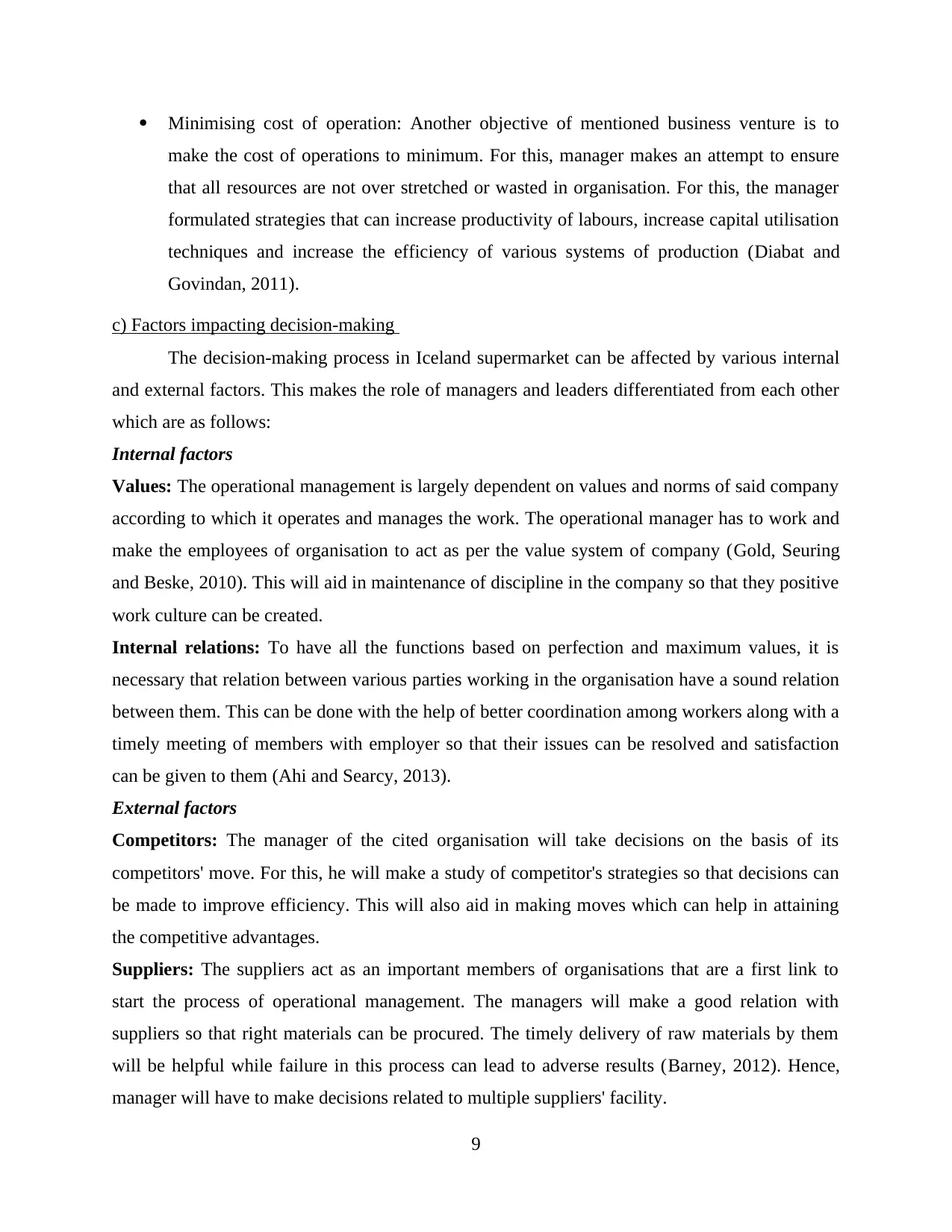
Minimising cost of operation: Another objective of mentioned business venture is to
make the cost of operations to minimum. For this, manager makes an attempt to ensure
that all resources are not over stretched or wasted in organisation. For this, the manager
formulated strategies that can increase productivity of labours, increase capital utilisation
techniques and increase the efficiency of various systems of production (Diabat and
Govindan, 2011).
c) Factors impacting decision-making
The decision-making process in Iceland supermarket can be affected by various internal
and external factors. This makes the role of managers and leaders differentiated from each other
which are as follows:
Internal factors
Values: The operational management is largely dependent on values and norms of said company
according to which it operates and manages the work. The operational manager has to work and
make the employees of organisation to act as per the value system of company (Gold, Seuring
and Beske, 2010). This will aid in maintenance of discipline in the company so that they positive
work culture can be created.
Internal relations: To have all the functions based on perfection and maximum values, it is
necessary that relation between various parties working in the organisation have a sound relation
between them. This can be done with the help of better coordination among workers along with a
timely meeting of members with employer so that their issues can be resolved and satisfaction
can be given to them (Ahi and Searcy, 2013).
External factors
Competitors: The manager of the cited organisation will take decisions on the basis of its
competitors' move. For this, he will make a study of competitor's strategies so that decisions can
be made to improve efficiency. This will also aid in making moves which can help in attaining
the competitive advantages.
Suppliers: The suppliers act as an important members of organisations that are a first link to
start the process of operational management. The managers will make a good relation with
suppliers so that right materials can be procured. The timely delivery of raw materials by them
will be helpful while failure in this process can lead to adverse results (Barney, 2012). Hence,
manager will have to make decisions related to multiple suppliers' facility.
9
make the cost of operations to minimum. For this, manager makes an attempt to ensure
that all resources are not over stretched or wasted in organisation. For this, the manager
formulated strategies that can increase productivity of labours, increase capital utilisation
techniques and increase the efficiency of various systems of production (Diabat and
Govindan, 2011).
c) Factors impacting decision-making
The decision-making process in Iceland supermarket can be affected by various internal
and external factors. This makes the role of managers and leaders differentiated from each other
which are as follows:
Internal factors
Values: The operational management is largely dependent on values and norms of said company
according to which it operates and manages the work. The operational manager has to work and
make the employees of organisation to act as per the value system of company (Gold, Seuring
and Beske, 2010). This will aid in maintenance of discipline in the company so that they positive
work culture can be created.
Internal relations: To have all the functions based on perfection and maximum values, it is
necessary that relation between various parties working in the organisation have a sound relation
between them. This can be done with the help of better coordination among workers along with a
timely meeting of members with employer so that their issues can be resolved and satisfaction
can be given to them (Ahi and Searcy, 2013).
External factors
Competitors: The manager of the cited organisation will take decisions on the basis of its
competitors' move. For this, he will make a study of competitor's strategies so that decisions can
be made to improve efficiency. This will also aid in making moves which can help in attaining
the competitive advantages.
Suppliers: The suppliers act as an important members of organisations that are a first link to
start the process of operational management. The managers will make a good relation with
suppliers so that right materials can be procured. The timely delivery of raw materials by them
will be helpful while failure in this process can lead to adverse results (Barney, 2012). Hence,
manager will have to make decisions related to multiple suppliers' facility.
9
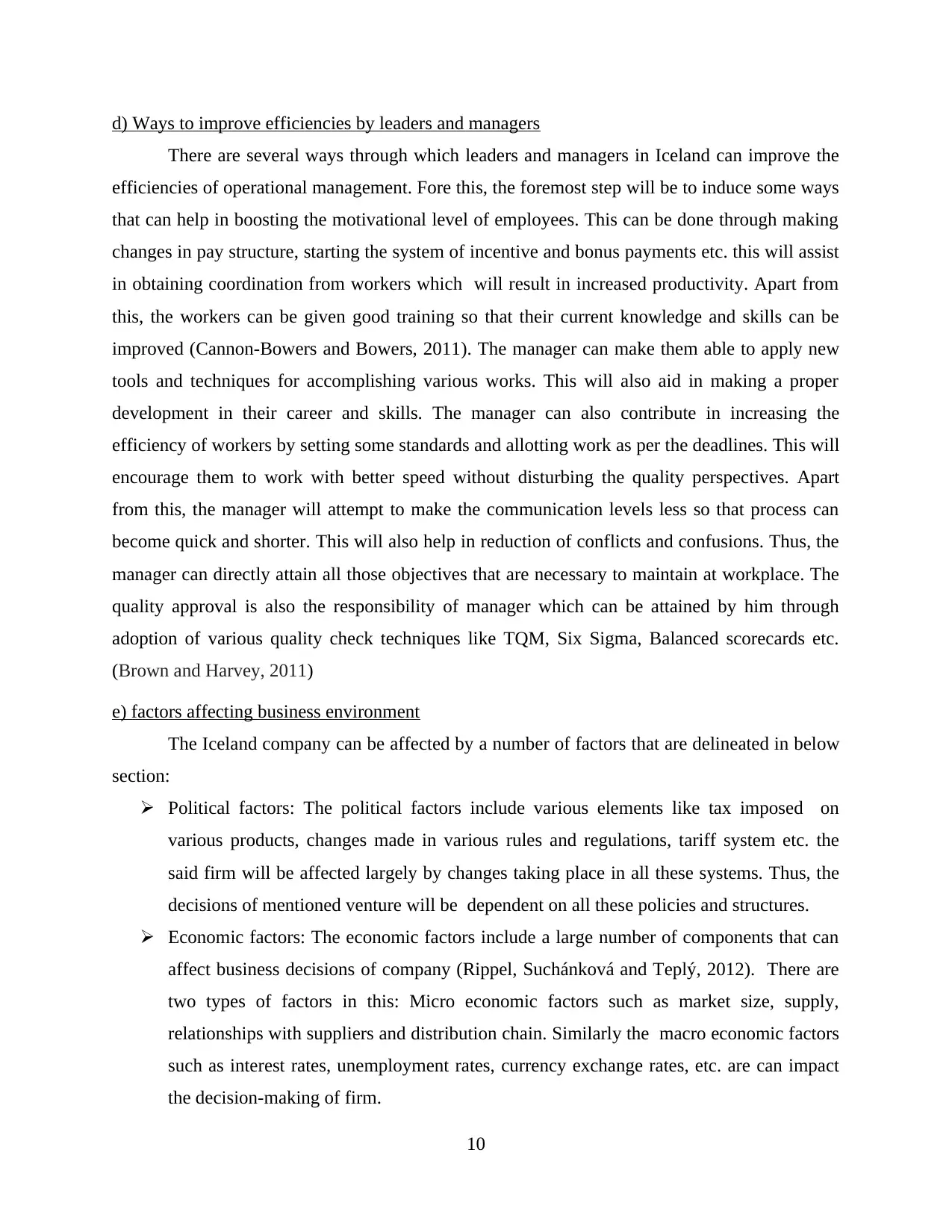
d) Ways to improve efficiencies by leaders and managers
There are several ways through which leaders and managers in Iceland can improve the
efficiencies of operational management. Fore this, the foremost step will be to induce some ways
that can help in boosting the motivational level of employees. This can be done through making
changes in pay structure, starting the system of incentive and bonus payments etc. this will assist
in obtaining coordination from workers which will result in increased productivity. Apart from
this, the workers can be given good training so that their current knowledge and skills can be
improved (Cannon-Bowers and Bowers, 2011). The manager can make them able to apply new
tools and techniques for accomplishing various works. This will also aid in making a proper
development in their career and skills. The manager can also contribute in increasing the
efficiency of workers by setting some standards and allotting work as per the deadlines. This will
encourage them to work with better speed without disturbing the quality perspectives. Apart
from this, the manager will attempt to make the communication levels less so that process can
become quick and shorter. This will also help in reduction of conflicts and confusions. Thus, the
manager can directly attain all those objectives that are necessary to maintain at workplace. The
quality approval is also the responsibility of manager which can be attained by him through
adoption of various quality check techniques like TQM, Six Sigma, Balanced scorecards etc.
(Brown and Harvey, 2011)
e) factors affecting business environment
The Iceland company can be affected by a number of factors that are delineated in below
section:
Political factors: The political factors include various elements like tax imposed on
various products, changes made in various rules and regulations, tariff system etc. the
said firm will be affected largely by changes taking place in all these systems. Thus, the
decisions of mentioned venture will be dependent on all these policies and structures.
Economic factors: The economic factors include a large number of components that can
affect business decisions of company (Rippel, Suchánková and Teplý, 2012). There are
two types of factors in this: Micro economic factors such as market size, supply,
relationships with suppliers and distribution chain. Similarly the macro economic factors
such as interest rates, unemployment rates, currency exchange rates, etc. are can impact
the decision-making of firm.
10
There are several ways through which leaders and managers in Iceland can improve the
efficiencies of operational management. Fore this, the foremost step will be to induce some ways
that can help in boosting the motivational level of employees. This can be done through making
changes in pay structure, starting the system of incentive and bonus payments etc. this will assist
in obtaining coordination from workers which will result in increased productivity. Apart from
this, the workers can be given good training so that their current knowledge and skills can be
improved (Cannon-Bowers and Bowers, 2011). The manager can make them able to apply new
tools and techniques for accomplishing various works. This will also aid in making a proper
development in their career and skills. The manager can also contribute in increasing the
efficiency of workers by setting some standards and allotting work as per the deadlines. This will
encourage them to work with better speed without disturbing the quality perspectives. Apart
from this, the manager will attempt to make the communication levels less so that process can
become quick and shorter. This will also help in reduction of conflicts and confusions. Thus, the
manager can directly attain all those objectives that are necessary to maintain at workplace. The
quality approval is also the responsibility of manager which can be attained by him through
adoption of various quality check techniques like TQM, Six Sigma, Balanced scorecards etc.
(Brown and Harvey, 2011)
e) factors affecting business environment
The Iceland company can be affected by a number of factors that are delineated in below
section:
Political factors: The political factors include various elements like tax imposed on
various products, changes made in various rules and regulations, tariff system etc. the
said firm will be affected largely by changes taking place in all these systems. Thus, the
decisions of mentioned venture will be dependent on all these policies and structures.
Economic factors: The economic factors include a large number of components that can
affect business decisions of company (Rippel, Suchánková and Teplý, 2012). There are
two types of factors in this: Micro economic factors such as market size, supply,
relationships with suppliers and distribution chain. Similarly the macro economic factors
such as interest rates, unemployment rates, currency exchange rates, etc. are can impact
the decision-making of firm.
10
⊘ This is a preview!⊘
Do you want full access?
Subscribe today to unlock all pages.

Trusted by 1+ million students worldwide
1 out of 15
Related Documents
Your All-in-One AI-Powered Toolkit for Academic Success.
+13062052269
info@desklib.com
Available 24*7 on WhatsApp / Email
![[object Object]](/_next/static/media/star-bottom.7253800d.svg)
Unlock your academic potential
Copyright © 2020–2025 A2Z Services. All Rights Reserved. Developed and managed by ZUCOL.





